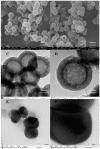Improved Gene Transfer with Functionalized Hollow Mesoporous Silica Nanoparticles of Reduced Cytotoxicity
- PMID: 28773087
- PMCID: PMC5551774
- DOI: 10.3390/ma10070731
Improved Gene Transfer with Functionalized Hollow Mesoporous Silica Nanoparticles of Reduced Cytotoxicity
Abstract
Gene therapy is a promising strategy for treatment of genetically caused diseases. Successful gene delivery requires an efficient carrier to transfer the desired gene into host cells. Recently, mesoporous silica nanoparticles (MSNs) functionalized with 25 kD polyethyleneimine (PEI) were extensively used as gene delivery carriers. However, 25 kD PEI could significantly reduce the safety of the modified MSNs although it is efficient for intracellular delivery of nucleic acids. In addition, limited drug loading remains a challenge for conventional MSNs drug carriers. Hollow mesoporous silica nanoparticles (HMSNs) with high pore volume, tunable pore size, and excellent biocompatibility are attractive alternatives. To make them more efficient, a less toxic 1.8 kD PEI polymer was used to functionalize the HMSNs which have large pore size (~10 nm) and form PEI-HMSNs. Scanning and transmission electron microscopic images showed that HMSNs were spherical in shape and approximately 270 nm in diameter with uniform hollow nanostructures. The maximum loading capacity of green fluorescent protein labeled DNA (GFP-DNA) in PEI-HMSNs was found to be 37.98 mg/g. The loading capacity of PEI-HMSNs was nearly three-fold higher than those of PEI modified solid nanoparticles, indicating that both hollow and large pores contributed to the increase in DNA adsorption. The transfection of GFP-DNA plasmid loaded in PEI-HMSNs was increased two-fold in comparison to that of 25 kD PEI. MTT assays in Lovo cells showed that the cell viability was more than 85% when the concentration of PEI-HMSNs was 120 µg/mL, whereas the cell viability was less than 20% when the 25 kD PEI was used at the same concentration. These results indicated that PEI-HMSNs could be used as a delivery system for nucleic acids due to good biocompatibility, high gene loading capacity, and enhanced gene transfer efficiency.
Keywords: PEI; cytotoxicity; gene transfer; hollow mesoporous silica nanoparticles.
Conflict of interest statement
We declare that we have no financial and personal relationships with other people or organizations that can inappropriately influence our works, there is no professional or other personal interest of any nature or kind in any product, service, and/or company that could be construed as influencing the position presented in, or the review of, the manuscript entitled.
Figures






Similar articles
-
Novel scheme for rapid synthesis of hollow mesoporous silica nanoparticles (HMSNs) and their application as an efficient delivery carrier for oral bioavailability improvement of poorly water-soluble BCS type II drugs.Colloids Surf B Biointerfaces. 2019 Apr 1;176:185-193. doi: 10.1016/j.colsurfb.2019.01.004. Epub 2019 Jan 2. Colloids Surf B Biointerfaces. 2019. PMID: 30616109
-
Fabrication of high specificity hollow mesoporous silica nanoparticles assisted by Eudragit for targeted drug delivery.J Colloid Interface Sci. 2015 May 1;445:151-160. doi: 10.1016/j.jcis.2014.12.053. Epub 2014 Dec 25. J Colloid Interface Sci. 2015. PMID: 25617610
-
Nanotechnology-Driven Delivery of Caffeine Using Ultradeformable Liposomes-Coated Hollow Mesoporous Silica Nanoparticles for Enhanced Follicular Delivery and Treatment of Androgenetic Alopecia.Int J Mol Sci. 2024 Nov 13;25(22):12170. doi: 10.3390/ijms252212170. Int J Mol Sci. 2024. PMID: 39596238 Free PMC article.
-
Mesoporous silica nanoparticles for drug and gene delivery.Acta Pharm Sin B. 2018 Mar;8(2):165-177. doi: 10.1016/j.apsb.2018.01.007. Epub 2018 Feb 12. Acta Pharm Sin B. 2018. PMID: 29719777 Free PMC article. Review.
-
Mesoporous silica nanoparticles: synthesis, classification, drug loading, pharmacokinetics, biocompatibility, and application in drug delivery.Expert Opin Drug Deliv. 2019 Mar;16(3):219-237. doi: 10.1080/17425247.2019.1575806. Epub 2019 Feb 7. Expert Opin Drug Deliv. 2019. PMID: 30686075 Review.
Cited by
-
Heat promotes melanogenesis by increasing the paracrine effects in keratinocytes via the TRPV3/Ca2+/Hh signaling pathway.iScience. 2023 Apr 26;26(5):106749. doi: 10.1016/j.isci.2023.106749. eCollection 2023 May 19. iScience. 2023. PMID: 37216091 Free PMC article.
-
Surface Modification of Poly(lactic-co-glycolic acid) Microspheres with Enhanced Hydrophilicity and Dispersibility for Arterial Embolization.Materials (Basel). 2019 Jun 18;12(12):1959. doi: 10.3390/ma12121959. Materials (Basel). 2019. PMID: 31216635 Free PMC article.
-
One-pot, degradable, silica nanocarriers with encapsulated oligonucleotides for mitochondrial specific targeting.Discov Nano. 2023 Dec 21;18(1):161. doi: 10.1186/s11671-023-03926-1. Discov Nano. 2023. PMID: 38127184 Free PMC article.
-
Efficient Active Oxygen Free Radical Generated in Tumor Cell by Loading-(HCONH₂)·H₂O₂ Delivery Nanosystem with Soft-X-ray Radiotherapy.Materials (Basel). 2018 Apr 12;11(4):596. doi: 10.3390/ma11040596. Materials (Basel). 2018. PMID: 29649155 Free PMC article.
-
The quest for nanoparticle-powered vaccines in cancer immunotherapy.J Nanobiotechnology. 2024 Feb 14;22(1):61. doi: 10.1186/s12951-024-02311-z. J Nanobiotechnology. 2024. PMID: 38355548 Free PMC article. Review.
References
LinkOut - more resources
Full Text Sources
Other Literature Sources

